The following article was published at RochesterSubway.com on 2010/02/16. Two weeks later 6 citizens got together and Reconnect Rocheseter was born.
America seems to have taken a renewed interest in mobility. Maybe due to President Obama’s recent commitment to high speed rail—or perhaps the positive results seen in towns like Portland and Denver have caught our collective attention. Whatever the reason, from the top down, people are rethinking our automobile-oriented culture—and getting excited about the possibilities.
There’s also good reason to focus on transportation as a way of jump-starting economic development. Industry requires access to people. And people need to have easy access to centers of employment. Continually improving access makes further development possible. Interrupting access will have the opposite effect. Likewise, doing nothing or simply maintaining existing infrastructure for an extended period of time will also hinder development.
For 30+ years Rochester has relied on the infrastructure choices it made in the 1950’s, 60’s, and 70’s. At that time we made development choices that encouraged our population to emigrate from the downtown core. We scrapped our extensive streetcar system, choked off downtown with the construction of the inner-loop, and paved super highways to take us from the city to the NY State Thruway and beyond. Since then that’s exactly where our money, our workforce, and our future have gone—down I-490 and out of state.
Rochester Deserves Better
Cities across the country from Portland to Denver to Kenosha WI have adopted urban planning strategies that are helping to catapult their towns ahead of the competition. One key lesson we should learn from these places is that it takes a fully integrated transportation strategy to create an environment that is conducive to growth. This strategy should include automobiles, buses, rail transit, bicycles, and pedestrians. For Rochester’s city core these focus areas translate in the following ways:
Issue 1: Roadways and Parking
Rochester drivers usually find little to complain about other than a few potholes in the winter months. Maggie Brooks would even say our roadways are “highly satisfying”. Our biggest problem is that we’ve got too many roads to maintain. And even parking downtown is typically not a problem—especially at night and on weekends.
Issue 2: RTS Buses and the Broken “Hub and Spoke”
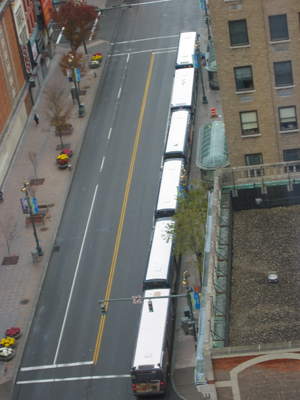 The small segment of the population that ride the bus will tell you it’s an okay system if not for the “hub and spoke” route setup. Just ask travelers who have to transfer downtown to get to locations across town—it’s confusing, a waste of time, and widely unpopular. The hub and spoke system also causes problems for downtown businesses due to the large number of riders waiting on Main Street to make their connections. You’d think crowds of people on Main Street would be a good thing. But not in this case
The small segment of the population that ride the bus will tell you it’s an okay system if not for the “hub and spoke” route setup. Just ask travelers who have to transfer downtown to get to locations across town—it’s confusing, a waste of time, and widely unpopular. The hub and spoke system also causes problems for downtown businesses due to the large number of riders waiting on Main Street to make their connections. You’d think crowds of people on Main Street would be a good thing. But not in this case ![]() .
.
Issue 3: Cyclists
Area cyclists generally love the Erie Canal bike path. But most will readily testify to the lack of bike lanes ![]() anywhere in the county—let alone in the city.
anywhere in the county—let alone in the city.
Issue 4: Pedestrians
Well, we couldn’t find any pedestrians to ask. And I’m not being facetious. This is a serious problem for Rochester. And it’s become our “chicken and the egg”. How do we attract pedestrians with the few businesses we have downtown? How do we attract businesses to downtown with the little traffic we have?
Fixing downtown will require us to take a hard look at each of these issues. We simply can’t address one without addressing them all. That leads me to…
Issue 5: Rail Transit
Duh, it’s non-existant. Yet there are great rewards that can be attained here. Now, I know what you’re thinking, “OH here we go again, this guy’s going to try and shove another ferry down my throat.” Just hear me out. I’m not lobbying for a giant commuter rail network—Rochester (as it is today) can’t support that. I am advocating for a short streetcar line — 8 to 10 miles — to connect the University of Rochester with Main Street and the East Ave district. That is a very achievable goal for Rochester.
Are Streetcars A Fit For Rochester?
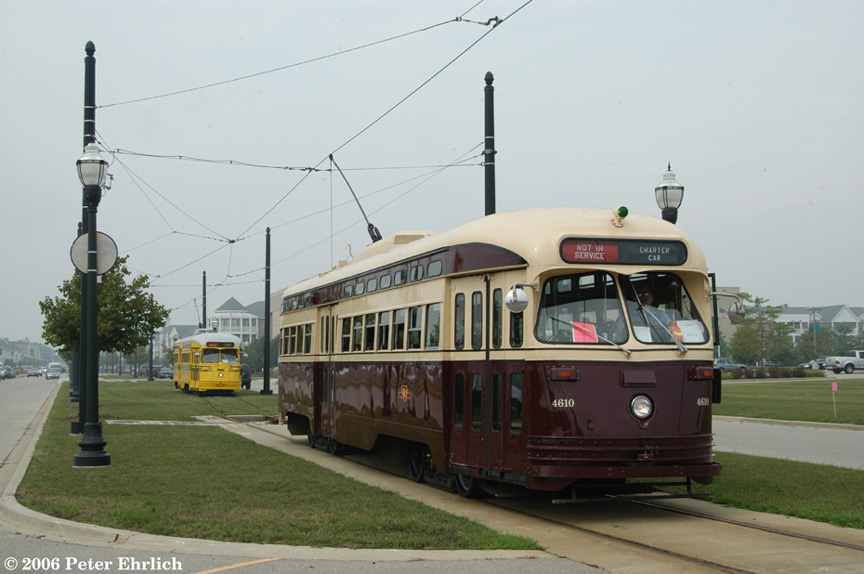 When you think of rail transit you probably think of larger cities like Denver or Seattle. But streetcars come in various flavors—making them the ideal solution for nearly any size town. While it doesn’t hurt for us to take pages from the planning playbooks of larger cities, it’s towns like Kenosha Wisconsin
When you think of rail transit you probably think of larger cities like Denver or Seattle. But streetcars come in various flavors—making them the ideal solution for nearly any size town. While it doesn’t hurt for us to take pages from the planning playbooks of larger cities, it’s towns like Kenosha Wisconsin ![]() and Savannah Georgia
and Savannah Georgia ![]() that should get us excited. Both of these cities are smaller than Rochester and have fewer people and thinner population densities—by more than half! Both of these cities have installed heritage streetcar lines within the past 10 years for less than $8 million combined. And both cities are now seeing once abandoned industrial corridors transformed into upscale development. We’ll take a closer look at these and other case-studies in a future post.
that should get us excited. Both of these cities are smaller than Rochester and have fewer people and thinner population densities—by more than half! Both of these cities have installed heritage streetcar lines within the past 10 years for less than $8 million combined. And both cities are now seeing once abandoned industrial corridors transformed into upscale development. We’ll take a closer look at these and other case-studies in a future post.
Encouraged by a few key signs, I think it’s very reasonable to assume streetcars can be a viable asset for our community over the long haul. First, RTS ridership continues to increase. According to Authority CEO Mark Aesch, ridership was up by ten percent from 2008 to 2009—while the national average was 4 percent. 1,700,000 more people got on an RTS bus in 2009 than did the year before—over 46,000 per day on average. Second, several large businesses have moved or are currently making plans to move into downtown. In addition, the residential market has shown signs of life over the past few years and additional developments are planned (including Midtown and Main & Gibbs). Downtown is ready for development to take off but there needs to be more incentive—a catalyst. Now consider this—new streetcar lines always, always, get more passengers than the bus routes they replace. Not only that, they attract development and businesses because investors like the permanence of streetcar lines. Bus routes come and go, but rails rarely pick up and move.
Other Key Benefits to Streetcars
- Rochester once had one of the most extensive streetcar networks in the world. For 50 years Rochester streetcars were widely used. They were privately owned & operated and were profitable. We know they can work here. They are tested and proven.
- Streetcars are generally much less expensive to install and maintain than any other form of rail. The cars themselves are smaller and the right-of-ways are already available to us.
- Streetcars are versatile and they are designed to fit in with their surroundings. They have the ability to operate along side vehicular and pedestrian traffic, and on many different types of alignments including city streets, residential streets, walkways, and green-ways.
- Streetcars are typically electric and are extremely quiet and clean (no more stinky buses on Main Street). And because they run on electricity they can be powered with domestic energy supplies and not foreign oil.
- Streetcars are not subways that hide underground, nor are they commuter trains that race through the countryside. Streetcars are highly visible and a very attractive amenity for potential city residents and businesses. They would become a symbol of Rochester and another selling point for our area.
- Streetcar lines are being built again all over the country and work just as well now as they did in the 1950’s when the federal government pulled the rug out from under them. Streetcars are not a new idea. People are familiar with them and they are commonly associated with “better places to live”.
- Streetcars appeal to middle and upper-middle-class people who have money to spend in stores, restaurants, and area businesses. Buses don’t attract many riders of choice.
- Developers are attracted to areas with streetcars because those streetcar lines represent a commitment to lasting, high quality transit service that they can count on for years to come. A bus route can disappear over night.
- A streetcar will never ship people to Toronto for them to spend money outside of Rochester. It would strictly serve the people and businesses in our area.
- We can start small and expand later. We’re not commitment to building something based on pure speculation **COUGH**FAST FERRY*. A streetcar line can start small and expand as it proves itself with ridership and private investment.
And the benefits go on and on. This one key investment could change everything for Rochester.
My proposal is this… A streetcar line should run east/west through the center of downtown Rochester connecting some of the most vibrant and vital areas of Rochester’s core with the areas that are primed and ready to benefit the most.
Proposed Initial Streetcar Route (click to open in Google Maps)…
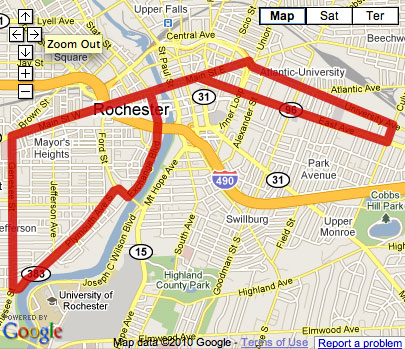
An initial 5 mile route (9.5 track miles) could connect an amazing array of neighborhoods and assets including:
• University of Rochester
• 19th Ward neighborhood
• Cornhill neighborhood
• Monroe County Civic Center
• War Memorial Arena
• Main Street Four Corners
• Riverside Convention Center
• Main Street & Clinton
• Midtown Plaza & Business District (Xerox, B&L, Paetec, etc.)
• Eastman Theater
• Museums and Art Gallery District
• Park Ave neighborhood
Possible Streetcar Extensions (click to open in Google Maps)…

With an additional 5.2 track miles (above) we could eventually extended service to include:
• Greater Rochester International Airport
• Amtrak Rail Station
The key to this idea would be getting RTS on board. Because overlapping a streetcar with bus routes doesn’t make much sense. Streetcars and buses need to work in tandem. That is, the streetcar line should cut thru downtown via Main Street, allowing north/south bus routes to feed into it at multiple points along its east/west route. The streetcar line would essentially become the “spine” of a modified RTS network… replacing the “hub and spoke” system and doing away with the pile of bus traffic at Main and Clinton. Bus transfers would still be made downtown but the streetcar would serve as a circulator. This would probably require 3-5 streetcars to be running simultaneously in order to provide a short enough headway for riders to make their connections easily. Here’s a look at how RTS bus routes would feed into this initial streetcar line…
*Thanks to Bob at urbanchamp.blogspot.com ![]() for his work on these bus routes. See his Toronto streetcar case-study
for his work on these bus routes. See his Toronto streetcar case-study ![]() .
.
Envisioning Streetcars in Rochester
Imagining a streetcar in downtown Rochester is not a difficult thing to do. During the first half of the twentieth century local companies built and operated one of the largest streetcar networks in the world—right here in Rochester. It almost didn’t matter where you lived or what street you worked on—most people could hop on a trolley in front of their home and ride it downtown. These beautiful workhorses helped build this town—their removal from our landscape left Rochester with a scar that has never fully healed. The picture above is painful for many of us. It’s a look at what we had and have lost. But the amazing thing about this photo is that it can also be a blueprint for our future.
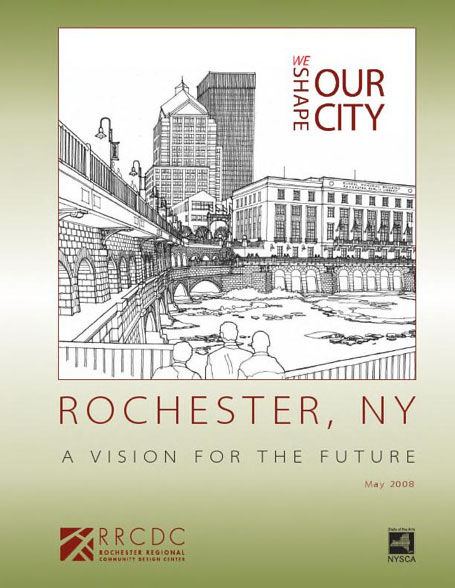 Rochester has a vision plan for its future…it’s true. “A Vision for the Future”
Rochester has a vision plan for its future…it’s true. “A Vision for the Future” ![]() is a community-based vision plan for downtown Rochester. It was developed and presented to the City of Rochester in 2007/2008 by the Rochester Regional Community Design Center
is a community-based vision plan for downtown Rochester. It was developed and presented to the City of Rochester in 2007/2008 by the Rochester Regional Community Design Center ![]() . A few of the recommendations made in this plan have been studied and are being implemented (i.e. Way-finding signage and landscaping improvements throughout the city). This is a good start but as time goes by and City leaders come and go, much of this vision plan may never get the attention it deserves. In my opinion there is one recommendation in this plan that has the ability to jump-start development throughout the core of the city and ignite economic growth. A trolley system. See page 109 of the report
. A few of the recommendations made in this plan have been studied and are being implemented (i.e. Way-finding signage and landscaping improvements throughout the city). This is a good start but as time goes by and City leaders come and go, much of this vision plan may never get the attention it deserves. In my opinion there is one recommendation in this plan that has the ability to jump-start development throughout the core of the city and ignite economic growth. A trolley system. See page 109 of the report ![]() .
.
The report focuses on Main Street as the obvious route for a contemporary streetcar line, citing the “physical majesty” of the area and its potential for becoming a “vibrant and symbolic heart of the community” as it once was. The plan also calls for many other aesthetic and functional improvements to Main Street such as giant planters that would separate pedestrian areas from traffic and curb extensions at all intersections. But the crown jewel would be the trolley line running east and west on both sides of the street—sharing the traffic lane closest to the curb with vehicular traffic. Transit shelters would be accommodated at intersections in the new curb extensions. It suggests contemporary-looking trolley cars, reflective of historic streetcars but not copies, distinct in color and pedestrian-friendly in appearance. It goes on to mention state-of-the-art electronic schedule/arrival announcement systems—but those are window dressings and we haven’t built anything yet. After all, a report is just a report if no one is willing to do anything with it. My intention is to take this ball and run with it.
Almost forgot, the video below will give you an idea for how streetcars operate in city streets and what they’re like on the inside. Although nothing is quite like the experience of actually riding in one.
Not With My Tax Dollars
 No doubt the main argument against this idea will be “This is NOT Denver or Portland. Rochester is small, and we’ve got bigger problems for our tax dollars to solve.”
No doubt the main argument against this idea will be “This is NOT Denver or Portland. Rochester is small, and we’ve got bigger problems for our tax dollars to solve.”
Well guess what. I agree—sort of. While I do agree that Rochester has very pressing needs that must be addressed immediately such as schools and public safety, I also know this: Any good business person will tell you if you’re not investing in your business it will fail. Rochester can be thought of as a business—and we are in direct competition with other small and midsize cities in NY and across the country. We compete with other cities for development and investment dollars. We compete with other communities for businesses and the tax dollars they provide. And we compete for population—which in return provides a work force as well as consumers who feed new development and businesses. As a community we need to make sure we’re continually investing in our schools and improving public safety while SIMULTANEOUSLY planning for long-term improvements in other things like infrastructure. If we can bring more people downtown, our schools benefit.
Rochester is small but our city is filled with smart, creative people and has access to incredible resources. With the right group of people and the right plan we can design and build a streetcar line that will drive development, create jobs, improve quality-of-life, and come to symbolize the spirit of this city—without diverting county or city tax dollars from other areas.
leave a comment.
Uh, Just How We Gonna Pay For This?
Obviously costs would vary based on a number of things—project length, type of cars (modern vs retro), streetcar stops (simple or elaborate) and on and on. Streetcar lines are generally a third of the cost of light rail (per track mile) and a starter line can range anywhere from $2.6 million per mile for a retro trolley line in Kenosha WI, to $30 million per mile for an ultra-modern system in Tacoma WA with several intermodal connections. We’ll look at case-studies from other cities at a later date.
For now let’s use the 5 mile (end-to-end) route we talked about earlier. As a loop that route would be about 9.5 track miles. With a cost per track mile of, say, $5 million (assuming minimal road work) that’s about $50 million. Add 3 LRV cars at $2.2 million each (like the Portland example shown above) and that takes us to $56.6 million. Then we’d need a trolley barn/maintenance facility—let’s call it $60 million. Now keep in mind, we could reduce that 9.5 miles of track if we needed to for Phase 1. And it’s also important to consider that streetcars typically hold 2-3 times the number of riders and last at least twice as long as a transit bus. With all that in mind, funding could come from a combination of federal and/or local sources…
Federal Assistance
Federal funding such as the Small Starts program, SAFETEA-LU, and grants could account for up to 50% of initial costs. The good news is that in January, the Department of Transportation announced a major transportation policy shift. The D.O.T. indicated that “new funding guidelines for major transit projects would be based on livability issues such as economic development opportunities and environmental benefits, in addition to cost and time saved, which were previously the primary criteria.” This means the FTA will now evaluate the environmental, community, and economic development benefits provided by transit projects, not just congestion relief benefits. This change opens up new possibilities if we were to consider applying for federal assistance. The downside to federal assistance, however, is in the red tape. The required environmental studies and approval process add years to the length of any project. Not a deal-breaker, but we all saw what happened with Renaissance Square ![]() .
.
Local Ownership
There are plenty of local funding options to explore. Many streetcar lines across the country are supported by public-private partnerships, since the benefits of streetcars on development and redevelopment efforts include: reduced parking requirements, an additional amenity for visitors, and an increased market area as other visitors and transit riders are drawn to the line. Rochester has seen no shortage of community involvement from its business community. Think of how many local businesses and institutions would benefit from a line that runs from the University of Rochester, thru Corn Hill to the Four Corners, down Main Street, and up the East End to Museum Row. A project that is built as a local partnership will increases the community’s sense of ownership and will be more likely to succeed. Other funding options might include state infrastructure bank loans, city bonds, parking revenue, tax-break agreements, and private donations.
Fiscal Sustainability
Once the line is built revenue can be generated from fares and a variety of other ways. For example, advertising (inside and outside the cars), and naming rights. The city of Tampa FL sold naming rights to its entire system for $1 million and even sold naming rights to each of its cars and stations. Patrons can also buy name plaques for streetcar benches. And something else to think about, over time as streetcar ridership increases, RTS/bus ridership would probably increase as well resulting in increased fare revenue.
But I don’t want us to assume that a streetcar line will be profitable right out of the gate. An initiative that serves the public requires some level of commitment from the public. Mark Aesch, CEO of RGRTA said it himself, “Any operation that is focused on moving people around will lose money.” Thanks to decades of Federal investment in the automobile-driven economy, this is generally true. RTS is subsidized, Amtrak is subsidized, all our roads and highways are subsidized, airports and even the airlines themselves are subsidized.
The “bottom-line” for a project like this is not entirely black and white. The value of these systems can only really be calculated over time and by looking at the overall growth of an entire region. Think about it—you wouldn’t argue that all the sidewalks in the city should be torn up because they’re costing us money and we can drive everywhere we need to go.
Next Steps
This proposal is only a rough draft of an idea. My next goal is to build a team of creative and business-minded people who can move this idea forward. What I don’t want to do point to another city and say “let’s build that”. Rochester needs a tailored solution that leverages our unique set of assets—an idea that the people of Rochester can get behind.
If you have expertise or connections in any of the following areas and would like to help, please leave a comment or contact me:
Rochester/Monroe County Government
Transportation (especially rail transit)
Urban Planning
Engineering
Law
Business Development/Finance
Marketing
I’m looking forward to continuing this conversation and hearing your opinion. If you have ideas and would like to help or know someone else who can help please leave a comment or contact me.
Without you, this is just a dream.


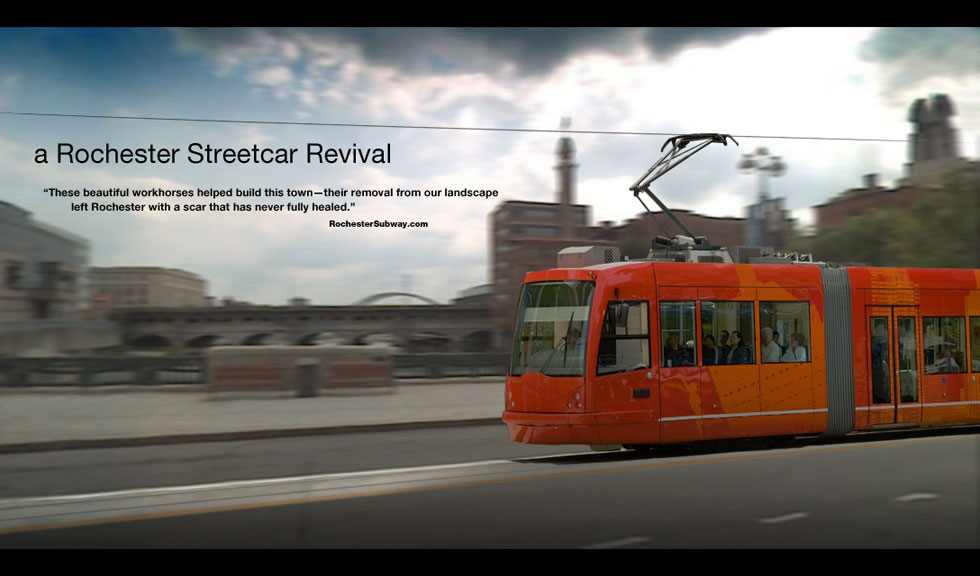


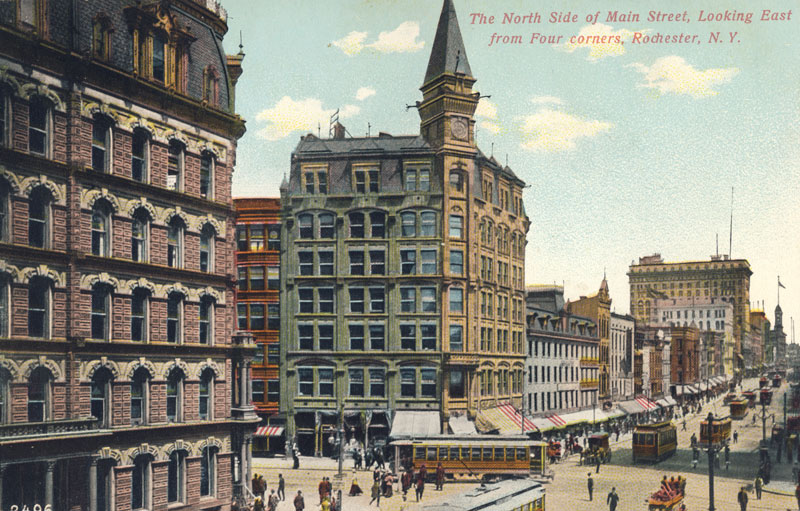
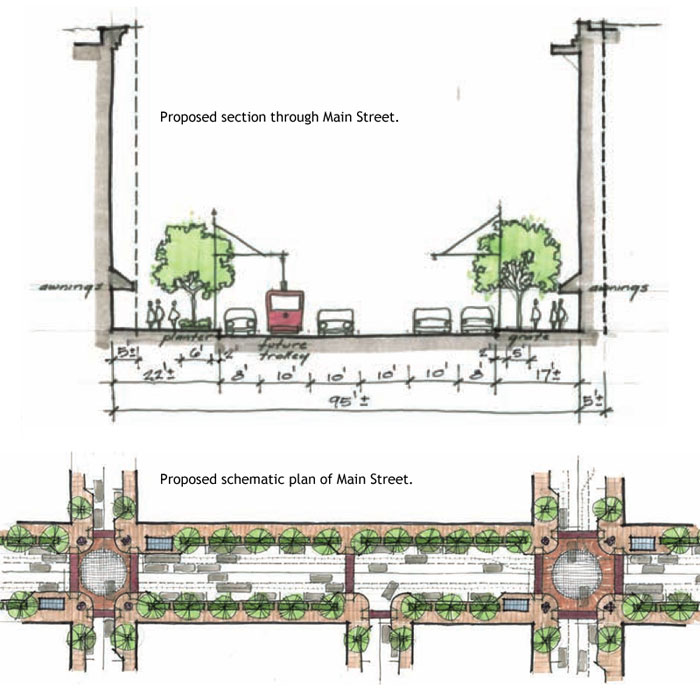
Why not consider BRT as a primer for new rapid transit? This is a better value than rail and does not require large up front investment.
Why not explore future use of the former Lehigh Valley Rail right of way? Rapid transit between RIT and downtown would connect two large student populations, Strong Hospital, and Corn Hill to downtown. This could become a density corridor.
The time is right we cannot stand idle
It is time for mass transportation to reconnect our City and Suburb.
Where would the stations be?
Great plan, well thought too. On a sidenote, I was thinking it might be more practical to have the east side line go down Monroe (instead of east) and then northeast up culver road, heading back downtown along university. Monroe ave has far more commercial activity and pedestrian life, and university is pretty busy as well. It would bring more ridership to the streetcars
How will stuff like this be affected by cap-and-trade? If there will be some semi-rational foumrla by which the creators of fixed mass transit lines could get a bunch of carbon credits that they could sell off to help finance their transit lines, that would be a hell of an incentive for cities to build them.And if they got even more credits for allowing major development around transit stops, they might consider changing their land-use regs, too.
I see this post is 12 years old but I think it’s a great idea!! I wish there was more traction with this, I know Buffalo is considering it more seriously.
Hi Katie! From our understanding, rebuilding a streetcar line isn’t completely off the table however the City would like to prioritize and improve our current bus system and ideally create a Bus Rapid Transit System.
-Jahasia Esgdaille, Community Engagement Manager